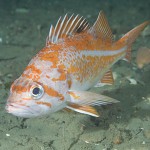
Salem, Ore. – The Oregon Fish and Wildlife Commission met today and set the 2015 harvest specifications and season structures for recreational and commercial groundfish that include significant changes to the composition of the seven fish daily bag limit for marine fish.
For the first time since 2004, anglers will be able to retain one canary rockfish as part of the daily bag limit beginning as early as March, thanks to on-going efforts to rebuild the stock. The exact date for the new rule will be announced following approval of a parallel federal harvest rule.
However, due to a decrease in federally determined harvest guidelines, anglers will be limited to three blue rockfish per day as part of the seven fish marine bag limit and the retention of China, copper and quillback rockfish will be prohibited. These regulations go into effect Jan. 15, 2015. ODFW staff had proposed a blue rockfish sub-limit of one per day, but after public testimony the Commission adopted a less-conservative limit of three blue rockfish per day.
The commercial nearshore fishery, which targets these same species, will see increased harvest limits for black rockfish and reduced limits for blue and other nearshore rockfish.
The Commission declined to take action on a staff proposal that would have allowed the use of barbed hooks when fishing for salmon, steelhead and trout in the lower Willamette River, Multnomah Channel, lower in Gnat Creek and inside Youngs Bay. A barbless hook rule went into effect in these areas in 2013 as part of the lower Columbia River Fisheries Management Reform package and was intended to reduce impacts on ESA listed salmon.
Instead, the Commission tabled the proposal based on a number issues including conservation concerns and consistency with the lower Columbia River Fisheries Management Reform rules. Commission Chair Mike Finley said the proposal could be discussed at a later date.
In other business, the Commission:
· Set by rule the average market price per pound of each species of fish commercially-harvested in Oregon. These values are adopted every January and are used to set damages in criminal cases associated with the unlawful taking of food fish.
· Heard updates and progress reports on:
o Status of implementation of management and reform rules for Columbia River Fisheries. Accomplishments for 2014 include continued enhancement of off-channel select areas with the release of over nine million salmon smolts; evaluation of new off-channel select areas; and implementation of a pilot commercial fall season seine fishery in the main stem.
o The stock status of white sturgeon in the lower Columbia River, where the latest abundance numbers in some age classes show an uptick. However, low adult abundance continues to be a concern.
o Creation of a framework to develop marine fishery management plans that will apply the principles of the ODFW Native Fish Conservation Plan and the Oregon Nearshore Strategy to marine species and fisheries.
o The 10-year revision of the Oregon Conservation Strategy and Oregon Nearshore Strategy, both of which are broad, overarching strategies for long-term conservation of Oregon’s native fish and wildlife. Revision of both strategies will have extensive public involvement and technical review and be brought to the Commission for approval by September 2015. The documents must be submitted to the U.S. Fish and Wildlife Service by Oct. 1, 2015.
The Fish and Wildlife Commission is the policy-making body for fish and wildlife issues in Oregon. It usually meets monthly. The next meeting will be Feb. 13, 2015 in Salem.
If you see local news happen, call the Horizon Broadcasting Group News Tip Hotline at 541-323-NEWS, or email us.















